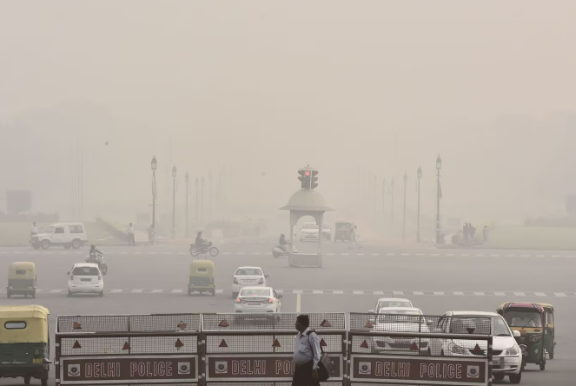Delhi Air Pollution Reaches Hazardous Levels Amid Diwali and Crop Burning
Delhi’s Air Quality Reaches Hazardous Levels Amidst Diwali and Winter Smog
Delhi’s air pollution has reached alarming levels, with PM2.5 readings spiking to 350 micrograms per cubic meter in some areas, far exceeding the World Health Organization’s (WHO) recommended safe limits. According to data from the SAFAR (System of Air Quality and Weather Forecasting and Research) website, the air quality index (AQI) in Delhi has been classified as “very poor” to “severe,” a seasonal hazard that returns each winter.
Factors Behind Delhi’s Seasonal Pollution Crisis
- Crop Stubble Burning: Every year, farmers in neighboring states such as Punjab and Haryana burn crop stubble to clear fields, releasing large amounts of smoke and particulate matter that drift toward Delhi. Despite government schemes for alternative stubble management, farmers report that they lack adequate financial and technical support, making crop burning the most accessible option.
- Diwali Fireworks: The Diwali festival, which involves lighting firecrackers, significantly worsens air quality in Delhi each year. Although the Delhi government has implemented a complete ban on the manufacture, storage, and sale of fireworks, the regulation is difficult to enforce fully as people procure fireworks from other states.
- Low Wind Speeds and Temperature Drops: Delhi’s winter weather compounds pollution levels, with low wind speeds trapping pollutants close to the ground. This results in a thick smog that envelopes the city, reducing visibility and increasing health risks.
- Vehicle Emissions and Dust: The high volume of vehicles on Delhi’s roads contributes to the steady increase in particulate matter, especially during the winter months. Construction activity in and around the city also releases dust, adding to the air quality problems.
Government Measures to Combat Pollution: The Graded Response Action Plan (GRAP)
To tackle air pollution, the Delhi government has activated the Graded Response Action Plan (GRAP). The plan includes several restrictions based on pollution levels:
- Ban on Diesel Generators: Diesel generator use is restricted to emergencies, with non-essential activities involving coal or firewood also banned.
- Limiting Construction Activity: Construction activity is curtailed to prevent the release of dust and other particulate matter into the air.
- Encouraging Public Transport: Authorities are urging residents to use public transport to cut down on vehicular emissions.
Health Advisory for Delhi Residents
Authorities have advised residents to stay indoors whenever possible, wear N95 masks outdoors, and use air purifiers at home. People with respiratory issues, children, and the elderly are especially vulnerable to the effects of air pollution during this season and should take extra precautions.
Long-Term Solutions Needed
While Delhi’s government has implemented immediate actions to address the smog, the problem requires comprehensive, long-term solutions. Better support for sustainable farming practices, stricter vehicular emission standards, and cross-state coordination could help to prevent this recurring pollution crisis.
As Delhi continues to grapple with hazardous air quality each winter, these measures are critical to safeguarding public health and improving the city’s air quality for the future.
